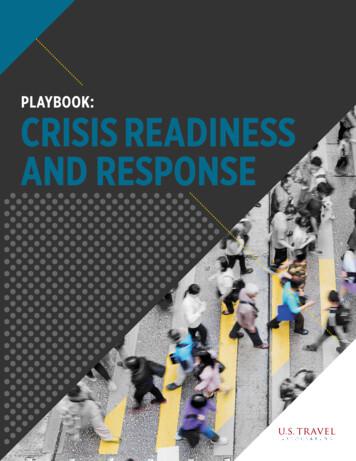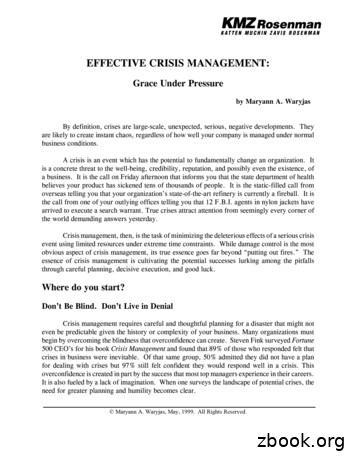Crisis Prevention Training
Crisis Prevention TrainingSenior Behavioral HealthSalt Lake Behavioral Health801 264-6000112/29/2015Crisis Prevention Training Goal: To provide the best care, welfare, safety andsecurity for the individuals in your charge, even inviolent moments.Presented by:Nina Ferrell, MAGeriatric Outreach CoordinatorSalt Lake Behavioral Health(801) 264-6000 Main(801) 419-7526 Cell12/29/201521. Systemic Steps Involved InPlanning for Behavioral Management Society/Community Corporation Facility Staff Individual Patient12/29/201531
2. Facility Based Risk Factors Maslow Hierarchy of Needs Layout Color/design Ambiance Staff Training Recreation Staff Engagement12/29/201543. Personal Influences Age Culture Religion Size Gender History of Trauma Education History Socioeconomic Factors Mental Illness and Anger Management Coping Skills12/29/201554. Safety Positions CPI Supportive Stance Kinetics Proxemics Para Communication12/29/201562
5. Environment of Care Options Sensory Programming and Engagement Perception Modalities-sound, touch, taste, sight andsmell Techniques-aroma therapy, music, visual stimulation,massage, blankets, tactile stimulation/items Equipment Supplies712/29/2015The CPI Development Model Crisis Development/Behavior Staff Attitudes/Approach1. Anxiety1. SupportiveA noticeable increase or changein behavior, (e.g., pacing, fingerdrumming, wringing of thehands, staring).An empathic nonjudgmentalapproach attempting toalleviate anxiety.812/29/2015CPI Development Model Crisis Development/Behavior1. Anxiety2. DefensiveThe beginning stage of loss ofrationality. At this stage, anindividual often becomesbelligerent and challengesauthority.12/29/2015 Staff Attitudes/Approach1. Supportive2. DirectiveAn approach in which a staffmember takes control of apotentially escalatingsituation by setting limits. Limit setting: a verbalintervention technique inwhich a person is offeredchoices andconsequences.93
CPI Development Model Crisis Development/Behavior Staff Attitudes/Approach1. Supportive2. Directive3. Nonviolent Physical CrisisIntervention1. Anxiety2. Defensive3. Acting-Out Person (AOP)Safe, non-harmful control andrestraint techniques used tocontrol an individual until hecan regain control of hisbehavior.Total loss of control which oftenresults in a physical acting-outepisode These techniques should beutilized as a last resort, when anindividual presents a danger toself or others.1012/29/2015CPI Development Model Crisis Development/Behavior Staff Attitudes/Approach1. Anxiety2. Defensive3. Acting-Out Person (AOP)4. Tension-ReductionDecrease in physical andemotional energy which occursafter a person has acted out,characterized by the regainingof rationality.12/29/20151. Supportive2. Directive3. Nonviolent Physical CrisisIntervention (NPCI)4. Therapeutic RapportAttempt to reestablishcommunication with anindividual who isexperiencing TensionReduction. Building relationshipswith individuals in ourcare.11Nonverbal Behavior Proxemics: personal space Kinesics: body posture and motion CPI Supportive Stance1. Communicates respect2. Non-threatening/non-challenging3. Staff personal safety/escape route12/29/2015124
Paraverbal Communication Paraverbal Communication: The vocal partof speech, excluding the actual words oneuses.Try to avoid inflection ofimpatience, condescension, etc. Volume: Keep volume appropriate fordistance and situation Cadence: Deliver your message using aneven rate and rhythm. Tone:1312/29/2015CPI Verbal Escalation Continuum1. Questioning2. Refusal3. Release4. Intimidation5. Intimidation Reduction1412/29/2015Verbal Escalation Continuum3. Release4. Intimidation5. Tension Reduction12/29/20152. Refusal1. Questioning155
Verbal Escalation Continuum1. Questioning:Information-seeking: a rational question seekinga rational response. Challenging:questioning authority orbeing evasive; attemptingto draw staff into a powerstruggle Intervention 1.2.3.Give a rational response.Stick to topic (redirect) and/or ignore challengeSet Limits if individual persists1612/29/2015Verbal Escalation Continuum2. Refusal: Noncompliance, slight loss ofrationality Intervention 1.2.3.Set l Escalation Continuum3. Release: Verbal acting out, emotional outbursts, lossof rationalization; blowing off steam, screaming,swearing, high-energy output. Intervention:A.) Allow them to let off steam, if possible.B.) Remove audience or acting out person from area.C.) When individual begins to quiet down, statedirectives that are non-threatening.D.) Use an understanding, reasonableapproach.E.) Be prepared to enforce any limits you set.12/29/2015186
Verbal Escalation Continuum4. Intimidation: Individual is verbally and/ornonverbally threatening staff in somemanner.Hands-on approach at this time may triggerphysical acting-out behavior. Intervention:A. Seek assistance and wait for team to intervene, ifpossible.B. Try to avoid individual intervention, as this is morelikely to jeopardize the safety and welfare of bothstaff and the AOI.1912/29/2015Verbal Escalation Continuum5. Tension-Reduction: A drop in energy, whichoccurs after every crisis situation, whether itis after a low-level defensive behavior or afterintimidation. Intervention: Establish Therapeutic Rapport: reestablishcommunication with the individual12/29/201520Setting LimitsKeys to Setting LimitsWhen you set limits, you are offering a person choices, as well asstating the consequences of those choices. Offer positive choice and consequences first, then negative choicesand consequence. You cannot force individuals to act appropriately. Trying to force aperson to act in a certain way often results in a nonproductive powerstruggle. Simple/clear, reasonable and enforceable12/29/2015217
Verbal Intervention Tips DO Remain calm Isolate situation Be professional Enforce limits Listen Be aware of non-verbals Be consistent DON’T Overreact Get in a powerstruggle Make false promises Fake attention Be threatening Use jargon2212/29/2015Empathic Listening Empathic listening is an active process todiscern what a person is saying.Remain nonjudgmentalGive undivided attention Listen carefully to what the person is reallysaying (focus on feelings not facts) Allow silence for reflection Use restatement to clarify messages 2312/29/2015Precipitation Factors, RationalDetachment, and Integrated Experience Precipitating Factors: Internal or external causes of an acting-out behaviorover which staff members have little or no control 12/29/2015Loss of personal powerNeed to maintain ed angerPsychological/physiological causes248
Rational DetachmentThe ability to stay in control of one’s own behaviorand not take behavior personally Key Points Staff may not be able to control precipitating factors,but they can control their own response to the actingout behaviors which result.A professional attitude must be maintained so that wecan control the situation without overreacting or actinginappropriately.Staff need to find positive outlets for the negativeenergy absorbed during a crisis.2512/29/2015Integrated ExperienceBehaviors and attitudes of staff impact the behaviors andattitudes of those in their care and vice versa. Individuals do not act out in a vacuum. Their behavioraffects staff and vice versa staff affects patients. If we stay in control when we encounter a disruptiveindividual, we can display a positive action which will notescalate the person’s behavior. Staying in control and being positive will allow us to offerthe best possible care, welfare, safety and security to theindividuals in our facilities.2612/29/2015Fear and AnxietyFear and anxiety are universal human emotions. Ourresponse to them is both psychological andphysiological. A negative reaction to fear/anxiety include: Freezing: inability to react to situation (e.g., stage fright) Overreacting: Psychologically – perceiving a situation as worse than itreally is. Physiologically – motor skills do not function normally Responding inappropriately: Verbally - saying things that are not pertinent to thesituation; using obscene or inappropriatelanguage.12/29/2015 Physically- striking out at someone; not being able to control 27our actions.9
Fear and Anxiety Productive reactions to fear/anxiety include : Increase in speed and strength – additionaladrenaline released into the bloodstream causesan almost superhuman increase in speed andstrength. Increase in sensory acuity – special alertness orsharpness of our senses take place. Decrease in reaction time – we take less time toreact than we would under normal circumstances.2812/29/2015Fear and Anxiety Ways to control fear and anxiety Understand what makes us afraid. Use techniques to protect both ourselves and theacting-out individual in a crisis. Use a team approach – don’t respond alone.Learn nonviolent physical intervention techniques tomanage acting-out individuals, if necessary.12/29/201529Philosophy of Nonviolent PhysicalCrisis Intervention Physical intervention should be used only as a lastresort when an individual is a danger to self orothers. Even at those moments, conduct an assessment todetermine the best course of action to maintain thecare, welfare, safety and security of all involved. There is risk involved in any physical intervention,therefore, physical intervention should be consideredonly in those moments where the danger beingpresented by the acting-out individual outweighs therisk inherent in physical interventions.12/29/20153010
Nonviolent Physical CrisisIntervention Techniques Nonviolent Physical Crisis Intervention techniques are designed tobe non-harmful and allow for a Therapeutic Rapport to bereestablished with the individual who lost control. Key elements of Nonviolent Physical Crisis Intervention responseinclude: Assessment of pain involved Attempts to calm down individual Individual not restrained on the floor, reducing risks of restraintrelated positional asphyxia and other injuries Team interventions are used Used only as a last resort when someone presents a danger – usedto protect not to punish By using physiological principles that do not rely on matchingstrength, staff involved are not in a “competitive” mindset The goal is to continually assess signs of tension-reduction and useopportunities to reestablish a therapeutic rapport with the individual.3112/29/2015CPI Personal Safety Techniques Two types of personal attacks:1.Grab: control or destruction of a part of one’sanatomy2.Strike: a weapon coming in contact with atarget12/29/201532Personal Safety Use physiological advantage by using: The weakest point of the grab Leverage Momentum Gain a psychological advantage by: Staying calm Having a plan Using the element of surprise or distraction12/29/20153311
Team InterventionTeam versus Solo Intervention Why team intervention?1. Safety – two people can handle an acting-out individual more safelythan one person can.2. Professionalism – team members can lend support to oneanother during a crisis situation.3. Litigation - having another person on the scene provides awitness to the intervention. Team Leader When a team leader arrives on the scene, he/she should takecontrol. The team leader can be any person on the team:1. The first person on the scene2. A team member with confidence and competence in handlingcrisis situations3. A team member who has rapport with the acting-out individual3412/29/2015Team InterventionTeam Leader Duties During a crisis situation, the team leader’s duties are to: Assess the situation. What steps are necessary?Plan the intervention.Instruct or cue the other team members.Communicate with the acting-out individual. To avoidconfusion, one person should talk with the acting-outperson. Auxiliary Team Duties 12/29/2015Check: Psychological status of the disruptive individual. Safety of the environment/remove dangerous objects.Address: What needs to happen to de-escalate the crisis35Postvention CPI Coping Model Postvention:Provides an opportunity to work towardchange and growth for individuals who haveacted out, as well as for staff members.Without the post-vention process such as theCOPING model, crises are likely to occurover and over again.12/29/20153612
Postvention The COPING Model for both Client and StaffPerspectivesControlOrient Patterns Investigate Negotiate Give 3712/29/2015For More Information Inpatient and Intensive Outpatient behavioral health services:Adults age 18 and over 12/29/2015General AdultCrisis StabilizationMedical Detox and Chemical Dependency TreatmentGeriatric UnitMen’s and Women’s Military Programs- Strong HopeSalt Lake Behavioral Health Hospital3802 S 700 ESLC, UT 84106(801) 264-6000 main(801) 419-7526 cell3813
Crisis Prevention Training Senior Behavioral Health Salt Lake Behavioral Health 801 264-6000 12/29/2015 2 Crisis Prevention Training Goal: To provide the best care, welfare, safety and security for the individuals in your charge, even in violent moments. Presented by: Nina Ferrell, MA G
2/18/2016 7 17 Crisis Intervention Training Programs Organization Name Website Calm Every Storm, Crisis Intervention Training Crisis Consultant Group, LLC. crisisconsultantgroup.com Management of Aggressive Behavior (MOA B) MOAB Training International, Inc. moabtraining.com Nonviolent Crisis Intervention Program Crisis Prevention Institute crisisprevention.com
ACCESS TO GENESEE COUNTY CRISIS SERVICES 08-2012 Additional Crisis Support Needed Emergency Department Refer to Hospital Emergency Dept. for emergent crisis needs that are unable to be met in community. Crisis Call Center GCCMH 24/7 Crisis Line (810) 257-3740 Crisis Needs Met With Crisis Call Center Phone Support CIRT
Crisis Lessons Learned In Crisis Management practice, few absolutes except: An effective Crisis Management program, that has adequate funding and management support, will only be put in place when facing an impending crisis that will produce significant losses. Every Crisis Is Different; If you've seen one crisis, you've seen one crisis.
DCPS School Crisis Response Plan Template 12 Roles and Responsibilities During a Crisis 14 Individual Student Crisis Protocol 17 Individual Student Crisis Plan Templates (Two Options) 20 . Each school has a crisis response plan and designated Lead for the school crisis team (SCT). 3. Central office conducts training and provides tools to .
Mobile Crisis Response – Crisis Safety Plan 3 Version 1-October 2019 Crisis Identification Crisis: Crisis is a series of actions or behaviors that, when taken in environmental and situational context, result in an
PRE-CRISIS PLANNING CRISIS RESPONSEPOSTCRISIS RECOER AN REIE When a crisis strikes, many organizations feel overwhelmed. That is why pre-crisis planning—in a time of clear-headed calm—is essential. Thorough planning and preparation can help ensure every front-line employee and organization leader is ready to manage a crisis. PART I: PRE-CRISIS
Stages of Crisis Management Stage One -- Pre-Crisis The pre-crisis stage of crisis management is the most effort intensive and also the most important. The buzzwords here are planning and prevention. Relying on wisdom, experience or savvy alone is a formula for disaster. Preparation and forethought are the foundation of effective crisis management.File Size: 357KB
INTRODUCTION 5 562, 579, 582, 585, 591, 592, 610). Population genetics, for example, identifies the conditions—selection pressures, mutation rates, population























